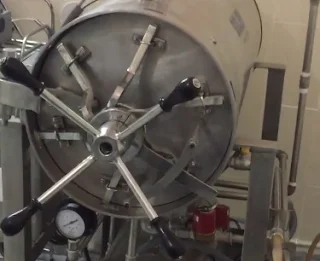Sterilization is critical within the pharmaceutical and medical industries. From direct patient care to laboratory work, huge numbers of instruments, containers, and equipment are used each day. With each new surface comes the risk of contamination by spores, bacteria, viruses, or other dangerous microbes. How then, can pharmaceutical specialists ensure the cleanliness of their tools?
 Regardless of size, autoclaves are self-sealing steel vessels which can be found in a variety of industries to perform sterilization or other scientific processes best carried out in high-pressure and high-temperature environments. Typically, the innards of an autoclave are cylindrical since this shape more easily withstands high pressures than a box or cube.
Regardless of size, autoclaves are self-sealing steel vessels which can be found in a variety of industries to perform sterilization or other scientific processes best carried out in high-pressure and high-temperature environments. Typically, the innards of an autoclave are cylindrical since this shape more easily withstands high pressures than a box or cube.
While the extraordinarily high pressures automatically create a seal from the outside world (the word "autoclave" is derived from "auto" and "clave," literally meaning "automatic locking"), external latches also exist to maximize safety.
Depending on the objects being sterilized, autoclave cycles must be manually set by a technician in order to produce the safest and most optimal sterilization parameters for the given load. In autoclave temperature increases as pressure increases. The relationship between temperature and pressure is as below.

1. Purge Phase: During the purge phase, steam displaces air within the autoclave chamber. Both temperature and pressure begin to increase.
2. Sterilization Phase: The exhaust remains closed, allowing the temperature and pressure to rapidly rise to the desired values. It is during this phase that the autoclave's harsh conditions destroy bacteria, spores, and other pathogens.
3. Exhaust Phase: Pressure is released from the chamber, but temperatures remain fairly high. Technicians should take care when removing hot contents from the autoclave.
Related: Sterility Assurance Level (SAL) and Log Reduction (D Value) in Sterilization
It is critical that autoclave technicians thoroughly understand the principle of autoclave sterilization to avoid safety hazards during use.
What is an Autoclave?
In 1879, Charles Chamberland developed the autoclave as a sterilization alternative to open flame techniques. While autoclaves (also called steam sterilizers in some settings) exist in varying shapes and sizes, the basic principle of autoclave sterilization is the same. Regardless of size, autoclaves are self-sealing steel vessels which can be found in a variety of industries to perform sterilization or other scientific processes best carried out in high-pressure and high-temperature environments. Typically, the innards of an autoclave are cylindrical since this shape more easily withstands high pressures than a box or cube.
Regardless of size, autoclaves are self-sealing steel vessels which can be found in a variety of industries to perform sterilization or other scientific processes best carried out in high-pressure and high-temperature environments. Typically, the innards of an autoclave are cylindrical since this shape more easily withstands high pressures than a box or cube.Types of Autoclaves
Tabletop autoclaves, roughly the size of a microwave oven, are often used in dental offices or small, private medical practices, while larger, horizontal autoclaves are frequently utilized in hospitals in order to handle larger volumes of equipment. Other autoclaves designed for use within the pharmaceutical industry function particularly with current Good Manufacturing Practices (cGMP) regulations in mind.How do Autoclaves Work?
The functionality of an steam sterilizer can be simply compared to a pressure cooker. By utilizing steam to create a high-pressure environment and maintaining a temperature too high for microbial survival, autoclaves are capable of successfully eliminating pathogens which may be resistant to soaps and detergents. The pervasiveness of the steam created within the autoclave allows for thorough sterilization within hollow instruments and other minuscule crevices which could be missed during cleaning with detergent.While the extraordinarily high pressures automatically create a seal from the outside world (the word "autoclave" is derived from "auto" and "clave," literally meaning "automatic locking"), external latches also exist to maximize safety.
Depending on the objects being sterilized, autoclave cycles must be manually set by a technician in order to produce the safest and most optimal sterilization parameters for the given load. In autoclave temperature increases as pressure increases. The relationship between temperature and pressure is as below.

The Stages of Autoclave Sterilization
The sterilization process includes several different phases, listed below.1. Purge Phase: During the purge phase, steam displaces air within the autoclave chamber. Both temperature and pressure begin to increase.
2. Sterilization Phase: The exhaust remains closed, allowing the temperature and pressure to rapidly rise to the desired values. It is during this phase that the autoclave's harsh conditions destroy bacteria, spores, and other pathogens.
3. Exhaust Phase: Pressure is released from the chamber, but temperatures remain fairly high. Technicians should take care when removing hot contents from the autoclave.
Related: Sterility Assurance Level (SAL) and Log Reduction (D Value) in Sterilization
Autoclave Limitations
While autoclaves remain extraordinarily versatile tools, some materials and substances are not compatible with autoclaves and could be dangerous if included within a load and entered into a sterilization cycle. For example, certain chemicals such as acids and bases should never be autoclaved, nor should materials made of polyethylene, polyurethane, or polystyrene.It is critical that autoclave technicians thoroughly understand the principle of autoclave sterilization to avoid safety hazards during use.



How we can calculate water consumption in vial washing machine
ReplyDelete